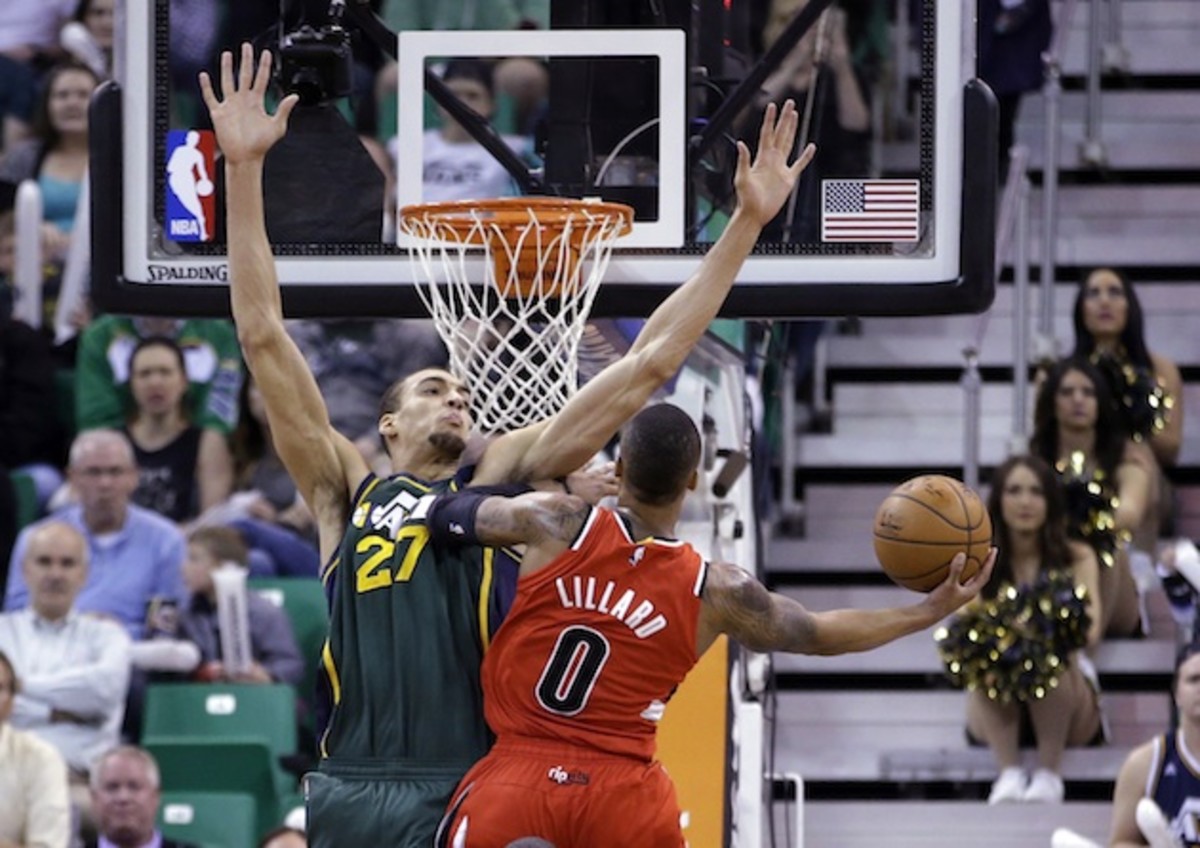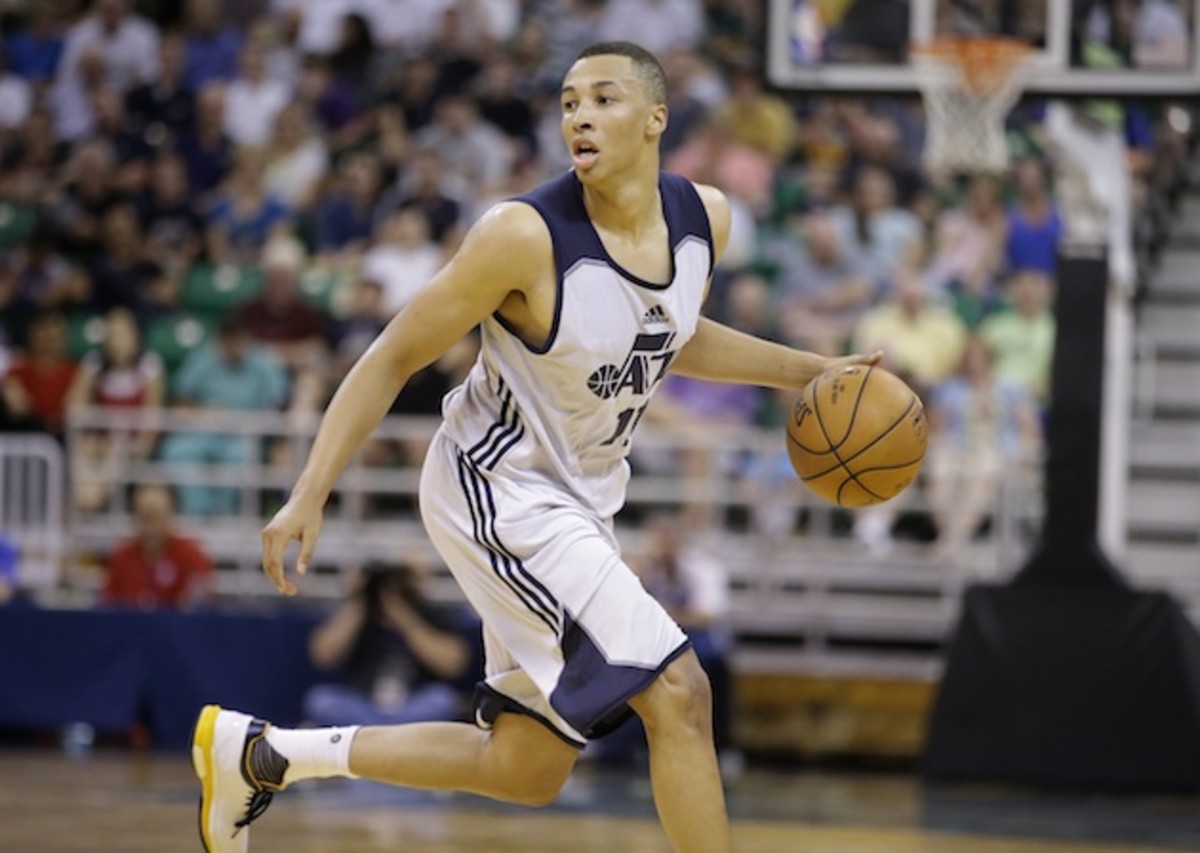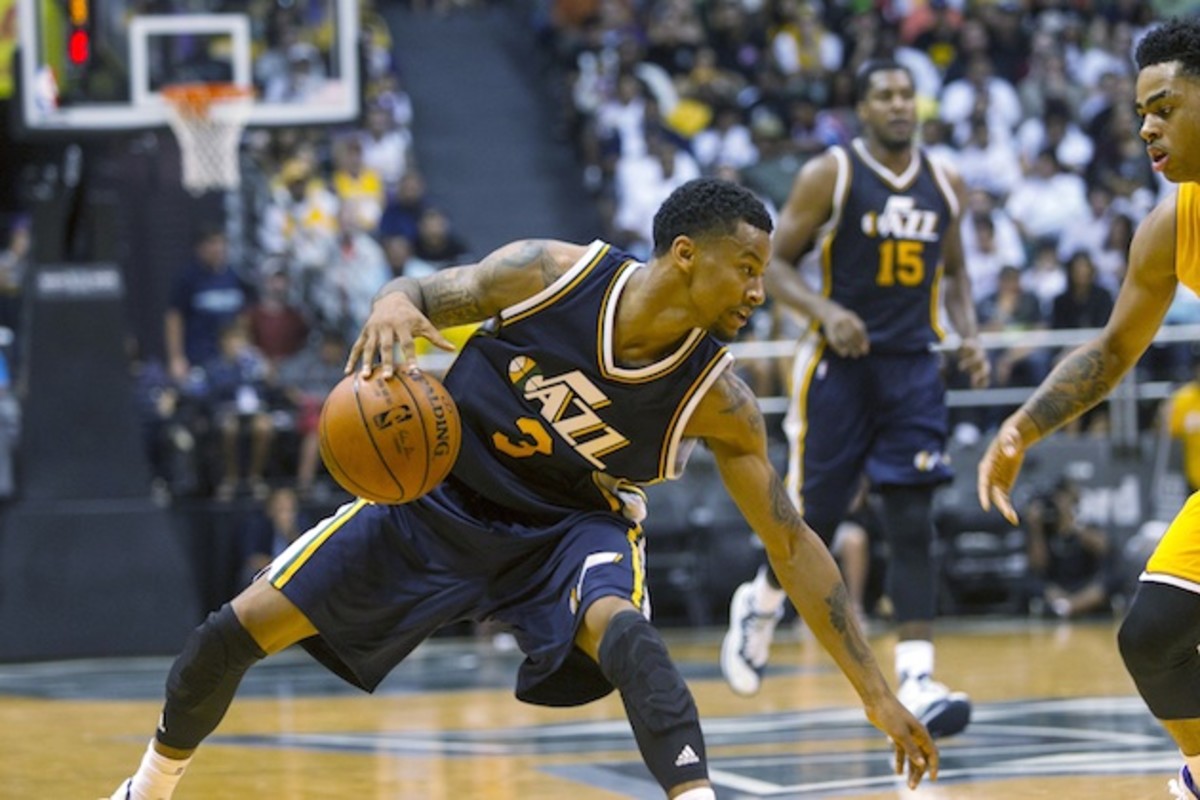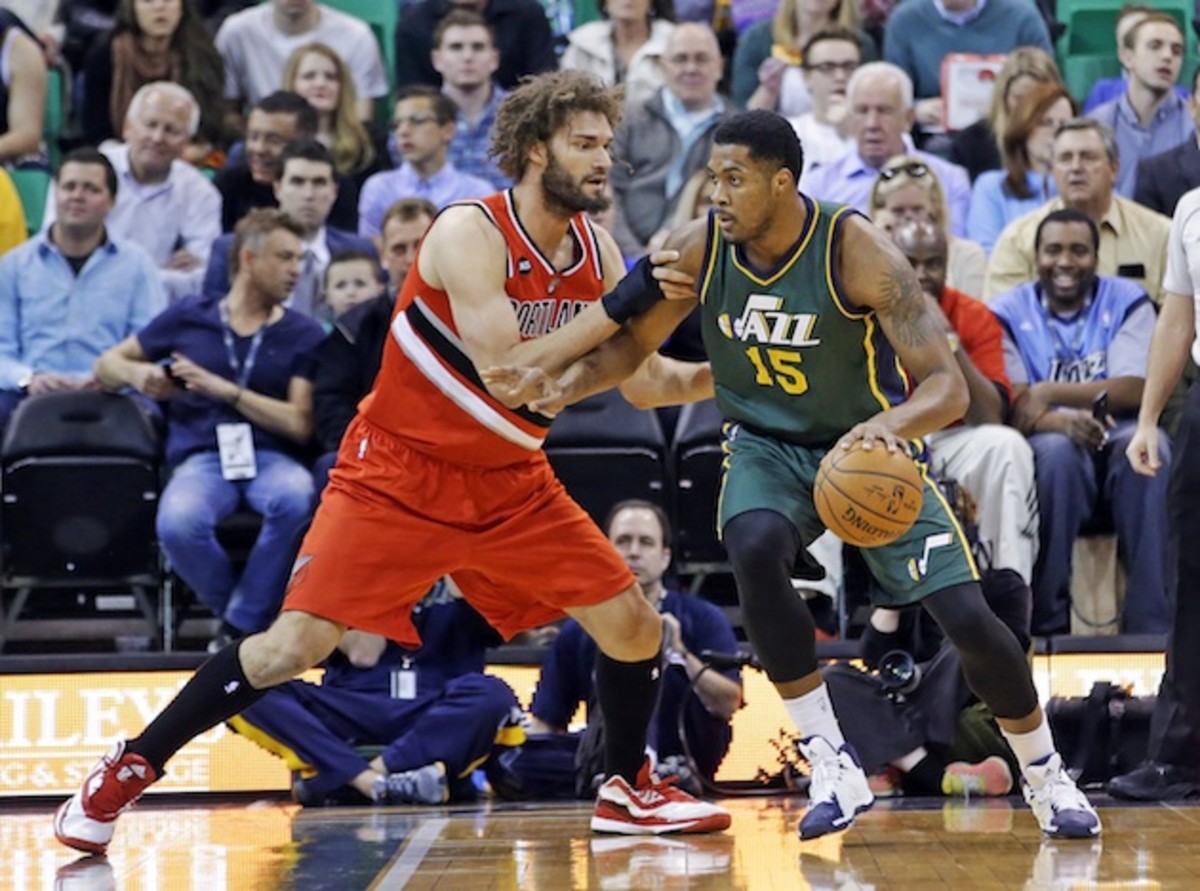Crossover Jazz: It may be the trendy pick, but Utah still has work to do

The Utah Jazz are such a trendy pick to be this year’s Milwaukee Bucks—the young lottery team from a season ago that makes an unexpected leap into the postseason—that they can no longer reasonably be called a sleeper. At this point, the playoffs are the expected destination, which is an odd thing to be saying about a team that finished last season with a record of 38–44, and would thus need at least an eight-win improvement to equal the 46.4-win average of the Western Conference’s last 10 No. 8 seeds.
Last year’s Jazz got to 38 wins in large part because of their 19–10 post All-Star record, good for sixth-best in the league. And it’s in the myriad factors behind those final 19 wins that many are basing Utah’s prospective leap. Specifically, the jump Utah’s defense took over the latter part of the season has many singing the Jazz’s tune—and for good reason.
Reinventing the New Orleans Pelicans
Through the break, Utah was hemorrhaging points at a rate higher than all but three teams. The Jazz were 24th in effective field goal percentage allowed, 24th in opponent’s turnover rate, and 29th in opponent’s three-point percentage. Put a simpler way: They were awful. But after trading Enes Kanter—arguably the league’s worst defender at his position—the day before their first post-break game, the Jazz quickly began stifling teams with near-historic efficiency.
Ditching Kanter meant freeing up more minutes for French rim-protection master Rudy Gobert, whose ascension was the primary factor—though, contrary to popular belief, not the only factor—in the team’s incredible turnaround. The 'Stifle Tower' logged just 21.9 minutes a night before the break, but that total spiked to 34.4 after it. Correspondingly, Utah’s defensive efficiency dropped 11.3 points, from 106.1 all the way down to 94.8 points per 100 possessions—the second-largest pre-to-post All-Star turnaround for any team, on either side of the ball, since 2000. (Only the 2011–12 Blazers’ 13.8-points per 100-possessions improvement in post-break defensive efficiency was greater.)

• MORE NBA: Booker ejected for swinging at Hibbert
The ripple effects of that defensive improvement were seismic. Prior to the All-Star break, the Jazz were outscored by a margin indicative of a 33.6-win team (using Pythagorean winning percentage, an estimate of team wins established by statistician Bill James). Basically, that’s a mid-rung lottery team. After the break, Utah’s scoring margin was that of a 55.7-win team—good enough, in most years, to win a division, and in some seasons would even lead the league.
Also, the Jazz’s improvement in net scoring margin (points scored minus points allowed per 100 possessions) from the first half of the season to the second was the third largest for any team this millennium. Only the 2003–04 Pistons (plus-10.7) and 2004–05 Nuggets (plus-11.5) registered steeper improvements than Utah’s plus-10.0 first-to-second half net rating differential.
Here’s the thing, though: Big second-half surges don’t necessarily ensure future success. For example, the 04–05 Pistons saw their win total hold steady at 54 the year after experiencing a post-break spike upon the acquisition of Rasheed Wallace. The 05–06 Nuggets, meanwhile, actually saw their win total drop from 49 to 44, and they’d shown even more second-half improvement than the Pistons squad.
That’s obviously a small sample, so it helps to widen the lens a bit. Even then, though, the data doesn’t conclusively point to a big follow-up year after an in-season improvement comparable to the one made by the Jazz. Six teams since 2000 have seen a post-break improvement in their net rating of at least 8.0 points. Those six teams actually won an average of 0.3 fewer games the following season. Over the same period, there were 16 teams that saw a post-break improvement of at least 6.5 points. The improvement: an average of only 0.2 games the following season.
Like some weird photo negative of the Pistons-Wallace acquisition in 2004, Utah’s surge was influenced—well, driven almost entirely—by an in-season trade that changed the composition of the roster. That’s not to say they definitively won’t make another leap in 2015–16; it’s just not a guarantee. Indeed, there remain plenty of factors—most of them personnel-related—that at least cloud the feeling of certainty around the Jazz’s supposedly imminent ascension.
Fittingly, those questions start at the one.

• MORE NBA: Different portrayals revealed in Sefolosha case
The Jazz used first-round picks in back-to-back drafts to help shore up the point-guard position, nabbing former Michigan man Trey Burke in 2013 and Australian man of mystery Dante Exum in 2014.
Exum, a rangy dynamo who practically oozes potential from his bones, already is out for the year, the victim of a torn ACL sustained while playing in an exhibition game for the Australian National Team. The loss is a major blow for Utah, not only because of Exum’s expected sophomore-year impact, but his overall development, as well. Exum has a ton of talent and is a promising defender, but he’s still raw and badly needs to improve his jumper and overall decision-making. That process is bound to be impeded by a full season of recovery and rehab.
In the wings waits Burke, a diminutive combo guard now entering his third season in the league. Having Burke run the show is far from optimal, and not just because he doesn’t bring the same size and length on defense as Exum (although, given that defense is how the Jazz will still have to make their bones, it certainly doesn’t help). To this point in his career, it would be hard to call Burke anything but a disappointment. During his two seasons at Michigan, Burke’s most incendiary strength was his knack for running the pick-and-roll—specifically in how he leveraged his ability to shoot off the dribble into easier looks for himself and his teammates. Sadly, that jumper has all but abandoned him in the pros.
Through two seasons, Burke is shooting 35.7% on shots outside the paint — a dreadful number, and one that’s spelled constant doom for his once-excellent pick-and-roll game. Among the 53 players to finish at least 250 possessions as a pick-and-roll ballhandler last season, Burke ranked 48th in points per play, per Synergy Sports. He shot terribly, never got himself to the free-throw line, and though he rarely turned it over, his drive-and-kick passes didn’t amount to all that much, either. Defenders know they don’t have to respect his shot, so they can play him to either drive to the rim or pass, which blocks lanes both to the basket and to his teammates.

• MORE NBA: Bonner talks to SI.com about his many collections
Even when Burke managed to sneak by his man and drive to the basket, his prowess in the paint was decidedly lacking. In fact, of the 26 players that recorded at least 500 drives last season (per SportVU data released by the NBA and STATS LLC), Burke ranked dead last in field goal percentage, and over 7.5 percentage points worse than the next closest player, D.J. Augustin. It wasn’t an anomaly, either; Burke was just as bad the year before — if not worse. He simply hasn’t proven he can be a consistent threat with the ball in his hands. That’s the kind of thing that dooms a point guard to irrelevance.
Burke’s struggles have caused many Jazz fans and media members to pin their point-guard hopes on the likes of Bryce Cotton and Raul Neto. Cotton had a cup of coffee with the team late last season, but he was really only given a sizable number of minutes in three or four games. And while he acquitted himself nicely enough, it’s tough to know what to expect from him at the NBA level without seeing more of him in actual action. (For more details, Cotton's skill set was profiled during summer league by Jody Genessy of the Deseret Newshere.)
Considering Cotton didn’t appear at all in Utah’s preseason opener against the Lakers, it seems unlikely he’ll be the stopgap savior many expect. Neto, on the other hand, saw 20 minutes of action backing up Burke, finishing the game with two points, two rebounds, six assists, and four steals. A Brazilian who had been playing in Spain since 2011, Neto seems like the more interesting prospect at this point. That said, counting on Neto, Cotton, or Burke to man the toughest position in the Western Conference isn’t exactly a recipe for success.
It stands to reason, then, that we’ll likely see head coach Quin Synder turn to lineups without a traditional point guard — something he tried during Utah’s preseason debut, when he rolled with a lineup of Alec Burks, Rodney Hood, Hayward, Favors, and Gobert toward the end of the first half. It’s a look that may only work against certain teams, but it’s far from radical; Hayward handles the ball as a de facto point guard much of the time anyway (a la James Harden), an arrangement that allows Utah to get both more shooting and more length on the floor by featuring Hood on the wing.
Hood's career commenced in fits and starts a year ago, the product of nagging injuries sustained prior to the season. His length played an important role in that second-half defensive surge, however. For the year, the Jazz allowed 4.6 fewer points per 100 possessions with Hood on the floor than off (though some of that can be attributed to playing over 60% of his minutes alongside Gobert). He also projects as one of the few reliable outside shooters on the roster. While conventional wisdom suggests Hood will come off the bench while Burke, Burks, and Hayward start, don’t be surprised if he winds up closing games out more often than not.
Getting Burks back—he sat out most of last season after injuring his shoulder and undergoing surgery in December—should help ease Hayward’s ballhandling burden a bit. But considering the relative lack of perimeter talent still on the roster, Utah is going to place a whole lot of offensive responsibility on the shoulders of a player that nearly crumbled under the sheer weight of it two seasons ago. Hayward bounced back in a big way last year, but it’s still a delicate balance that needs to be managed correctly. Given his undeniable talent and versatility, you want Hayward playing that leading role, without piling too much on his plate at once.
Having Gobert and Favors take the next developmental step would be extremely helpful in that regard. Gobert is a pogo stick, but he can’t really score outside the immediate area of the basket, and the rest of his offensive game remains a work in progress. Still, encouraging signs abounded last season.

• CAULDRON: Teams primed to challenge Cavs in East
Gobert made significant strides finishing at the basket and—in a hugely important development—at the free-throw line. His improved clip at the stripe is especially noteworthy, given how much teams love to foul guys like Gobert at the rim. If his free-throw numbers start to crater, expect Gobert to be a candidate for the Andre Drummond/DeAndre Jordan Hack-A treatment.
In another positive bellwether, Gobert raised his assist total from seven as a rookie to 109 as a sophomore, all while slashing his turnovers by 50% (as a percentage of total possessions). The assist-to-turnover ratio is still out of whack, but at least it’s trending in the right direction. He even dished some pretty nifty passes that suggest he has more in the way of technical skill and vision than his pre-draft specs let on.
Meanwhile, Favors made his own strides last season, taking a more active role in the offense without sacrificing much in the way of efficiency. Like Gobert, Favors dished out more assists while cutting down on his turnovers. He continued to get after it on the offensive glass. He also showed a bit more range on his jumper, inching over 40% on shots between 10 and 16 feet from the rim, and over 30% on shots between 16 feet and the three-point arc — both for the first time. More importantly, these upticks are reflective of multiyear improvements for the burly forward, who, let’s not forget, is still just 24 years old.
Indeed, the continued stretching of Favors’s range may prove the most critical piece to Utah’s ever-evolving offensive puzzle. More importantly, it makes the one-two punch of a Favors-Gobert frontcourt — the polished big with range alongside the impossibly long defensive anchor — all the more potent. After all, the Jazz scored only 100.4 points per 100 possessions when their two big men shared the floor last season, and they were actually slightly worse (100.1) after the All-Star break. Much of this can still be attributed to Gobert’s offensive anemia anywhere beyond a foot or two, putting even more pressure on Favors to create a bit more space with his improved jumper.

• CAULDRON: Durant doesn't owe Stephen A. Smith anything
Predictably, one of the first stories to come out of Jazz training camp was how Favors is working to become more of a stretch four. Which is all well and good, to the extent Utah needs to generate more room in the paint. Whether it’ll actually work, only time will tell. But it’s clear the Jazz can’t expect to make their run to the playoffs a reality with two of their most important players registering such woeful numbers when they’re on the floor together.
Still, even if Utah’s rise is nowhere near the guarantee it’s being painted as in some circles, that doesn’t mean optimism isn’t warranted. You don’t just play all-time great defense for a third of a season by some happy accident. Gobert should still be expected to rank among the very best defensive players in basketball, and that alone should help Utah stay toward the top of the league in point prevention. Hayward is still an ascendant star, capable of carrying a heavy offensive load both on and off the ball. Favors is still a double-double machine, and slight improvement from him on either or both ends could make a world of difference.
Even beyond their core three, the Jazz boast plenty in the way of young, potential-laden talent. Burke, Burks, Hood, Joe Ingles, Tibor Pleiss, Elijah Millsap, and rookie Trey Lyles all have skill sets that should be able to flourish if put in position to succeed. Even Jeff Withey, the gangly seven-footer from Kansas, is fascinating as a kind of poor-man’s Gobert coming off the bench.
Given how they recovered from their sluggish start last season to finish within seven games of a postseason berth—to say nothing of the likely decline of the Blazers and Mavericks—it’s more than reasonable to pencil the Jazz in as contenders for one of the final two or three spots in the Western Conference playoff race. Just make sure the one you use has an eraser at the end of it.

